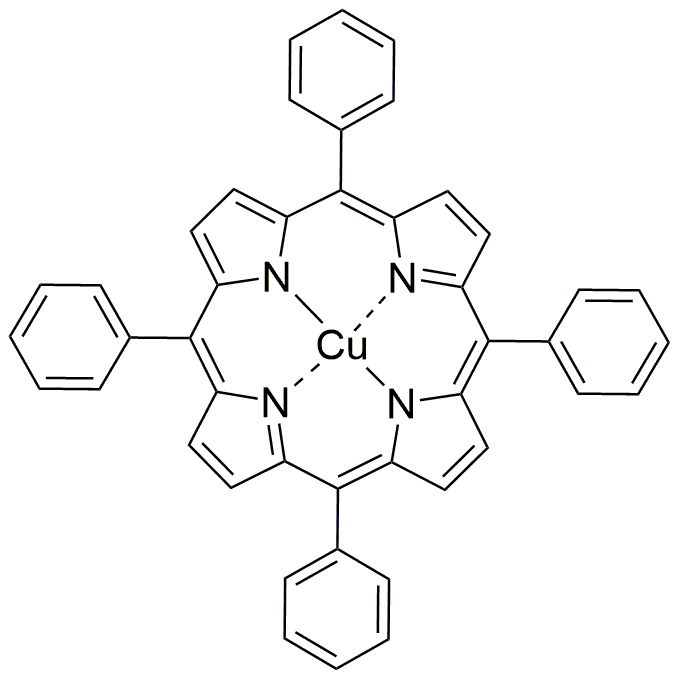Copper(II) tetraphenylporphyrin is widely utilized in research focused on:
- Photodynamic Therapy: This compound is effective in medical applications, particularly in treating certain cancers. Its ability to generate reactive oxygen species upon light activation makes it a promising agent for targeted therapy.
- Electrochemical Sensors: It is used in the development of sensors for detecting various analytes. Its unique electronic properties enhance sensitivity and selectivity, making it ideal for environmental monitoring and food safety applications.
- Catalysis: The compound serves as a catalyst in various chemical reactions, including oxidation processes. Its stability and efficiency can lead to reduced reaction times and improved yields in industrial chemical synthesis.
- Solar Energy Conversion: In the field of renewable energy, it is applied in dye-sensitized solar cells. Its light-absorbing properties contribute to higher energy conversion efficiencies, making solar technology more viable.
- Biochemical Research: Researchers utilize it as a model compound to study porphyrin behavior and interactions in biological systems, aiding in the understanding of metalloporphyrins in enzymatic processes.
General Information
Properties
Safety and Regulations
Applications
Copper(II) tetraphenylporphyrin is widely utilized in research focused on:
- Photodynamic Therapy: This compound is effective in medical applications, particularly in treating certain cancers. Its ability to generate reactive oxygen species upon light activation makes it a promising agent for targeted therapy.
- Electrochemical Sensors: It is used in the development of sensors for detecting various analytes. Its unique electronic properties enhance sensitivity and selectivity, making it ideal for environmental monitoring and food safety applications.
- Catalysis: The compound serves as a catalyst in various chemical reactions, including oxidation processes. Its stability and efficiency can lead to reduced reaction times and improved yields in industrial chemical synthesis.
- Solar Energy Conversion: In the field of renewable energy, it is applied in dye-sensitized solar cells. Its light-absorbing properties contribute to higher energy conversion efficiencies, making solar technology more viable.
- Biochemical Research: Researchers utilize it as a model compound to study porphyrin behavior and interactions in biological systems, aiding in the understanding of metalloporphyrins in enzymatic processes.
Documents
Safety Data Sheets (SDS)
The SDS provides comprehensive safety information on handling, storage, and disposal of the product.
Product Specification (PS)
The PS provides a comprehensive breakdown of the product’s properties, including chemical composition, physical state, purity, and storage requirements. It also details acceptable quality ranges and the product's intended applications.
Certificates of Analysis (COA)
Search for Certificates of Analysis (COA) by entering the products Lot Number. Lot and Batch Numbers can be found on a product’s label following the words ‘Lot’ or ‘Batch’.
Numéro de catalogue
Numéro de lot/série
Certificates Of Origin (COO)
This COO confirms the country where the product was manufactured, and also details the materials and components used in it and whether it is derived from natural, synthetic, or other specific sources. This certificate may be required for customs, trade, and regulatory compliance.
Numéro de catalogue
Numéro de lot/série
Safety Data Sheets (SDS)
The SDS provides comprehensive safety information on handling, storage, and disposal of the product.
DownloadProduct Specification (PS)
The PS provides a comprehensive breakdown of the product’s properties, including chemical composition, physical state, purity, and storage requirements. It also details acceptable quality ranges and the product's intended applications.
DownloadCertificates of Analysis (COA)
Search for Certificates of Analysis (COA) by entering the products Lot Number. Lot and Batch Numbers can be found on a product’s label following the words ‘Lot’ or ‘Batch’.
Numéro de catalogue
Numéro de lot/série
Certificates Of Origin (COO)
This COO confirms the country where the product was manufactured, and also details the materials and components used in it and whether it is derived from natural, synthetic, or other specific sources. This certificate may be required for customs, trade, and regulatory compliance.


